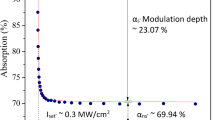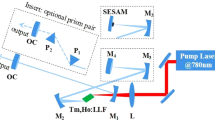Abstract
A diode-pumped passively mode-locked Yb:CTGG disordered crystal laser has been demonstrated for the first time to our knowledge. With a semiconductor saturable absorber mirror for passive mode locking and two Gires–Tournois interferometer mirrors for dispersion compensation, pulses as short as 389 fs at a repetition rate of 45 MHz were obtained at the central wavelength of 1,037.8 nm. The maximum average power was 420 mW, corresponding to pulse energy of 9.3 nJ and peak power of 24 kW.
Similar content being viewed by others
Avoid common mistakes on your manuscript.
1 Introduction
Femtosecond lasers have wide applications in numerous scientific and engineering fields such as ultrafast spectroscopy, metrology, and superfine material processing. The requirements of the science and industrial worlds are constantly promoting the search for compact, efficient, and low-cost lasers that provide high pulse energy and high average power. Ytterbium-doped crystals were verified to be ideal candidates to realize femtosecond oscillations, mainly due to the weak thermal load and broad absorption bands. The wide absorption band centered at 980 nm agrees well with the emission wavelength of well-developed InGaAs diode. In addition, the simple electronic structure of Yb3+ ion is benefiting for avoiding loss processes such as excited-state absorption, up conversion, and concentration quenching.
Basically, the generated mode-locked pulse duration is limited by the gain bandwidth of laser crystal. In view of this, laser crystals with strong inhomogeneous broadening are much helpful to generate ultrafast pulses. In the so-called disordered crystals, the cationic ions are randomly distributed in the lattice sites. Such structure can form multiple types of substitutional sites, which provides strong inhomogeneous lattice field for rare earth dopants, and correspondingly leads to large ground-state stark splitting and broad emission spectra. Thus, the disordered crystals have gained much attention for applications in ultrafast lasers. So far, sub-100 fs lasers based on the Yb-doped disordered crystals have been realized, such as Yb:Ca4YO(BO3)3 [1], Yb:Sr3Y(BO3)3 [2], Yb:SrY4(SiO4)3O [3], Yb:NaY(WO4)2 [4], Yb:Ca4GdO(BO3)3 [5], Yb:NaY(MoO4)2 [6], Yb:LuScO3 [7], Yb:CaGdAlO4 [8], and Yb:CNGG [9]. Recently, the laser characteristics of a novel Yb-doped disordered crystal—Yb:Ca2.85Ta1.80Ga3.10O12 (CTGG)—have been investigated for the first time by our group (under review). More than 2 W of continuous-wave (CW) and 36.8 ns pulses with passively Q-switching were also achieved. Similar to many other disordered crystals, Yb:CTGG possesses a broad absorption band (~30 nm FWHM centered at 930 nm) and an emission band (~30 nm FWHM centered at 1,036 nm). In addition, Yb:CTGG has an upper level lifetime of 0.77 ms, which is comparable with Yb:Lu2O3 (0.82 ms) [10], Yb:Sc2O3 (0.8 ms) [10], Yb:CNGG (0.79 ms) [11] and Yb:GGG (0.8 ms) [12], and minor than that of Yb:YAG (1.01 ms) [12]. Too long upper-state lifetime will counteract soliton stabilization and result in the difficulty to stabilize a CW mode-locked laser [13]. As a member of Yb-doped crystal based on cubic hosts, Yb:CTGG has a relatively large emission cross section of 17 × 10−21 cm2, which is larger than some of the other members, such as Yb:Sc2O3 (14.4 × 10−21 cm2) [10], Yb:Lu2O3 (12.8 × 10−21 cm2) [14], and Yb:LuScO3 (9 × 10−21 cm2) [7]. The results indicate that Yb:CTGG should be a promising gain medium for ultrashort pulse laser operation.
In this letter, we demonstrate the characteristics of the continuous-wave mode-locked operation of a diode-pumped Yb:CTGG laser with a partial reflectivity semiconductor saturable absorber mirror (SESAM). The pulses as short as 389 fs with an average power of 420 mW have been obtained at 1,037.8 nm by group delay dispersion compensation.
2 Experimental setup
In the experiments, an uncoated, 5-mm-long 2 at. % Yb-doped CTGG crystal with an aperture area of 3 mm × 3 mm was directly pumped by a fiber-coupled laser with a 200 μm fiber-core diameter and a numerical aperture of 0.22. By using a 1:1 optical collimation system, the focused pump beam in the crystal had a radius of 100 μm. The small signal absorption of the crystal at pump wavelength was measured to be about 75 %. The femtosecond laser characteristics were investigated in a 3.4-m-long standard resonator, as schematically shown in Fig. 1. The gain medium was water cooled at 13 °C and placed close to the input mirror. The crystal was placed with a small incidence angle with respect to the cavity axis to suppress the etalon effect. With such a so-called gain-at-the-end laser, the spatial hole burning will be enhanced. The emission band will be effectively inhomogeneously broadened considering the population grating and saturated gain flattening [15]. These effects are quite favorable for the generation of ultrashort pulses. The laser waist inside the gain medium with the ABCD matrix formalism calculated was 118 μm × 108 μm in radii, which were efficiently matched with the pump laser beam. The SESAM (BATOP GmbH, Germany) had a saturation fluence of 70 μJ cm−2, a modulation depth of 1.6 % and transmission of 4 %. The laser mode was focused with a 200-mm radius-of-curvature mirror onto SESAM with a radius of 42 μm in sagittal plane and a radius of 41 μm in tangential plane. The GDD introduced by the Yb:CTGG crystal was estimated to be ~720 fs2 [group velocity dispersion (GVD) of 144 fs2/mm × 5 mm]. To reduce the intracavity losses and keep our oscillator compact and robust, we compensated the intracavity dispersion with two plane Gires–Tournois interferometer negative-dispersion mirrors (GTI1 and GTI2, Layertec GmbH), which provide a second-order dispersion compensation of nearly −1,300 and −600 fs2 per reflection in the spectral range from 1,030 to 1,040 nm, respectively. An amount of −1,900 fs2 per round-trip was introduce to compensate the GDD inside the cavity and balance the self-phase modulation (SPM) introduced by the Kerr nonlinearity of the gain medium, which was experimentally proved to be suitable for achieving femtosecond operation for this resonator.
3 Results and discussion
Continuous-wave operation of Yb:CTGG laser was first performed by replacing the SESAM with an output coupler with 5 % transmission and without GTI mirrors in the cavity. The threshold absorbed pump power was measured to be 1.6 W, as shown in Fig. 2, and the output power was found to be linearly increased with the absorbed pump power. A maximum output power of about 1.1 W was obtained.
To realize femtosecond operation, the SESAM and two GTI mirrors were used in the resonator. By aligning the input mirror and the position of SESAM, a stable mode-locked laser was realized. The average output powers with the dispersion compensated are shown in Fig. 2. When the absorbed pump power exceeded 4.1 W, a metastable Q-switched mode-locking operation occurred. As the absorbed pump power was increased to be 5.6 W, continuous-wave mode-locking (CWML) was achieved, which could be maintained in an absorbed pump region from 5.6 to 7.1 W corresponding to average output powers of 276–420 mW of average output power, respectively. Figure 3 shows the recorded pulse trains in time span of 50 ns and 1 ms, demonstrating a good amplitude stability at the pulse repetition rate of 45 MHz, which matched with the cavity round-trip time. If the absorbed pump power was increased above 7.1 W, as shown in the Fig. 2, the average output power still increased, whereas the output pulse trains became unstable and a QML tendency was observed. We attributed this phenomenon to that the thermal lensing effect of the gain medium deviated from the set value for designing cavity to obtain CWML operation. Under the average output power 420 mW, we achieved 389 fs pulses (by assuming a sech2 profile) with the typical autocorrelation trace shown in Fig. 4a. Figure 4b shows the corresponding spectrum centered at 1,037.8 nm with a FWHM of 3.7 nm.
The dependences of central wavelengths and FWHM of the emission spectra on the absorbed pump power were measured as presented in Fig. 5. It is worth to be mentioned that the spectra were red-shifted within the range from 1,034.2 to 1,037.8 nm with the absorbed pump power increased from the threshold to 7.1 W. As the heat generated inside the gain medium accumulated with the increased absorbed pump power, the variable thermal focal lens made the oscillation laser mode distribution continuously change. Therefore, the mode distribution of the pump light and exciting light does not matched perfectly. The absorption introduced by the unpumped part of gain medium while in the laser oscillation area forces the laser output spectrum to red-shift [16]. Moreover, the FWHM tended to become broader when the laser turned from QML to CWML operation, which implied more longitudinal modes were locked in CWML regime. The time-bandwidth product was 0.4, indicating nearly transform limited (0.315). The pulses energy and peak power were calculated to be 9.3 nJ and 24 kW, respectively. Figure 6 shows the radio frequency (RF) spectra of the first beat centered with a corresponding signal-to-noise ratio of ~58 dBc. The inset of Fig. 6 shows the RF spectra recorded on a wide-span of 1 GHx and the clearness implies a good mode-locking stability.
4 Conclusion
In conclusion, we have demonstrated a diode-pumped femtosecond Yb:CTGG laser for the first time. With dispersion compensation, 389 fs pulses at the central wavelength of 1,037.8 nm were obtained with an output power of 420 mW, corresponding to pulse energy of 9.3 nJ and peak power of 24 kW. Considering the excellent spectral properties and high thermal conductivity of Yb:CTGG crystal, we believe that the mode-locking performance of this laser could be further improved by optimization the Yb-doped concentration and of optical homogeneity.
References
A. Yoshida, A. Schmidt, H. Zhang, J. Wang, J. Liu, C. Fiebig, K. Paschike, G. Erbert, V. Petrov, U. Griebner, Opt. Express 18, 24325 (2010)
F. Druon, S. Chénais, P. Raybaut, F. Balenbois, P. Georges, R. Gaumé, G. Aka, B. Viana, S. Mohr, D. Kopf, Opt. Lett. 27, 197 (2002)
F. Druon, S. Chénais, P. Raybaut, F. Balenbois, P. Georges, R. Gaumé, P.H. Haumesser, B. Viana, D. Vivien, S. Dhellemmes, V. Ortiz, C. Larat, Opt. Lett. 27, 1914 (2002)
A. García-Cortés, J.M. Cano-Torres, M.D. Serrano, C. Cascales, C. Zaldo, S. River, X. Mateos, U. Griebner, V. Petrov, IEEE J. Quantum Electron. 43, 758 (2007)
F. Druon, F. Balembois, P. Georges, A. Brun, A. Courjaud, C. Hönnnger, F. Salin, A. Aron, F. Mougel, G. Aka, D. Vivien, Opt. Lett. 25, 423 (2000)
A. Schmidt, S. River, V. Petrov, U. Griebner, X. Han, J.M. Cano-Torres, A. García-Cortés, M.D. Serrano, C. Cascales, C. Zaldo, J. Opt. Soc. Am. B 25, 1341 (2008)
A. Schmidt, V. Petrov, U. Griebner, R. Peters, K. Petermann, G. Huber, C. Fiebig, K. Paschke, G. Erbert, Opt. Lett. 35, 511 (2010)
Y. Zaouter, J. Didierjean, F. Balembois, G. Lucas Leclin, F. Druon, P. Georges, J. Petit, P. Goldner, B. Viana, Opt. Lett. 31, 119 (2006)
A. Schnidit, U. Griebner, H.J. Zhang, J.Y. Wang, M.H. Jiang, J.H. Liu, V. Petrov, Opt. Commun. 283, 567 (2010)
P. Klopp, V. Petrov, U. Griebner, K. Petermann, V. Peters, Opt. Lett. 29, 391 (2004)
H.J. Zhang, J.H. Liu, J.Y. Wang, J.D. Fan, X.T. Tao, X. Mateos, V. Petrov, M.H. Jiang, Opt. Express 15, 9464 (2007)
L.D. Deloach, S. Payne, L. Chase, L. Smith, W. Kway, W. Krupke, IEEE J. Quantum Electron. 29, 1179 (1993)
F. Friebel, F. Druon, J. Boudeile, D.N. Papadopoulos, M. Hanna, P. Georges, P. Camy, J.L. Doualan, A. Benayad, R. Moncorgé, C. Cassagne, G. Boudebs, Opt. Lett. 34, 1474 (2009)
U. Griebner, V. Petrov, K. Petermann, V. Peters, Opt. Express 12, 3125 (2004)
B. Braun, K.L. Weingarten, F.X. Kärtner, U. Keller, Appl. Phys. B 61, 429 (1995)
J.F. Wu, S.B. Jiang, T.Q. Qua, M. Kuwata-Gonokami, N. Peyghambarian, Appl. Phys. Lett. 87, 211118 (2005)
Acknowledgments
This work was supported by the National Nature Science Foundation of China (Grant Nos.: 61275142, 91022003, and 51021062).
Author information
Authors and Affiliations
Corresponding authors
Rights and permissions
About this article
Cite this article
Lou, F., Guo, SY., He, JL. et al. Diode-pumped passively mode-locked femtosecond Yb:CTGG laser. Appl. Phys. B 115, 247–250 (2014). https://doi.org/10.1007/s00340-013-5596-x
Received:
Accepted:
Published:
Issue Date:
DOI: https://doi.org/10.1007/s00340-013-5596-x










